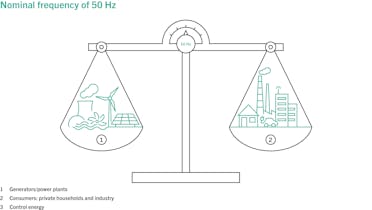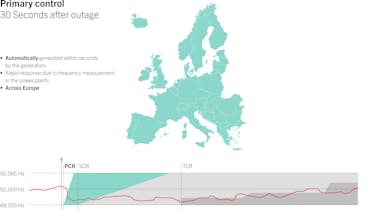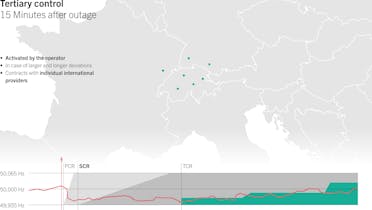Electricity cannot be stored in the transmission grid, so the amount of electricity fed in must always be the same as the amount of electricity fed out. This means the production and consumption of energy must always be balanced. This equilibrium ensures the secure and stable operation of the grid at a constant frequency of 50 Hertz. The Swiss transmission grid is not the only one that is operated at a frequency of 50 Hertz; the same is true for the entire European interconnected grid. Swissgrid works together with the other transmission system operators to ensure that the frequency in this interconnected grid can be maintained at all times.
If unforeseen fluctuations arise, the operators in the grid control rooms use control energy, a reserve that power plants keep available for Swissgrid and that can be retrieved as required. The power plants either increase or decrease their power to compensate for any missing or excess electrical energy.
In the European interconnected grid, the balance between production and consumption is achieved via a three-stage process: first, primary control energy is activated. The turbines of the power plants throughout Europe respond to frequency fluctuations and increase or decrease their power accordingly. After a few minutes, the secondary control replaces the primary control. The power is provided by Swiss power plants, which receive an automatic signal from Swissgrid. After 15 minutes, the operators manually switch to tertiary control energy. They instruct individual domestic or international power plants to feed more or less energy into the grid.
Schedule management – the foundation of a constantly balanced grid
Careful planning together with the power plants and electricity traders is essential to make sure that the grid is always in equilibrium. Swissgrid is responsible for making sure that the transmission grid in Switzerland is always in balance. This also means the power plants and electricity traders always need to feed precisely as much energy into the grid (i.e. produce or purchase) as they sell.
One day before operation, the power plants and electricity traders send schedules of their national and international electricity trading transactions to the grid control rooms. The operators closely inspect the trading transactions and coordinate them with colleagues from the international transmission system operators. That is how they check whether the sum of all the trading transactions by the power plants and electricity traders is in balance, among other things. The schedules can be adjusted until shortly before as well as during operation. These cross-border preparations make it possible for the transmission system operators to ensure that the entire European interconnected grid remains in balance and to prevent fluctuations.










